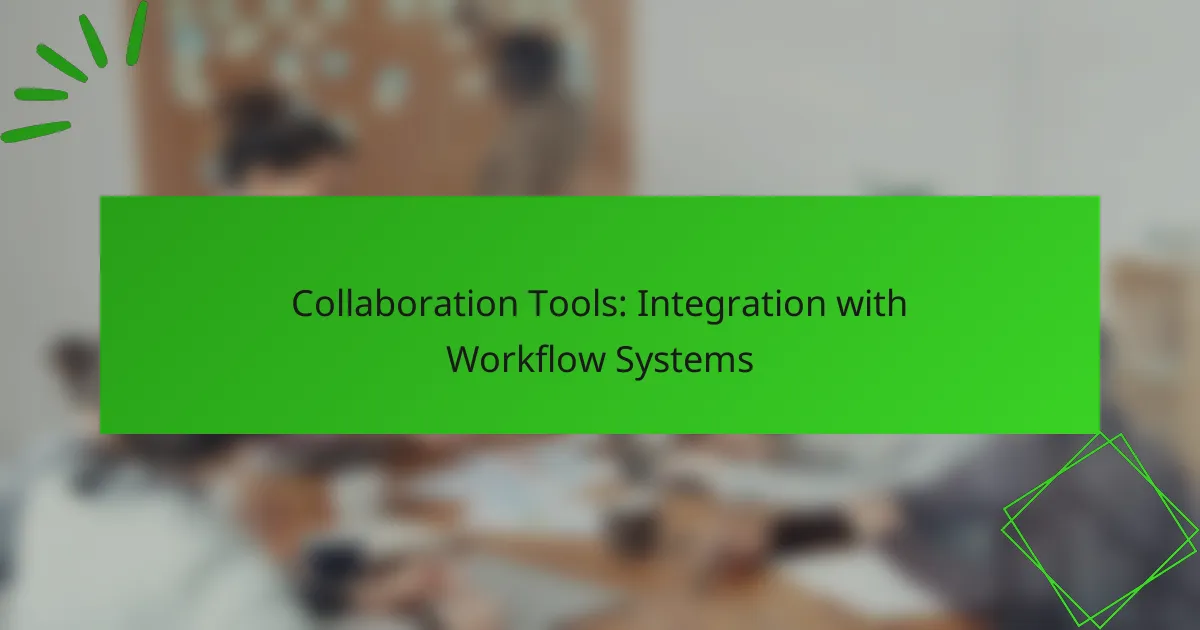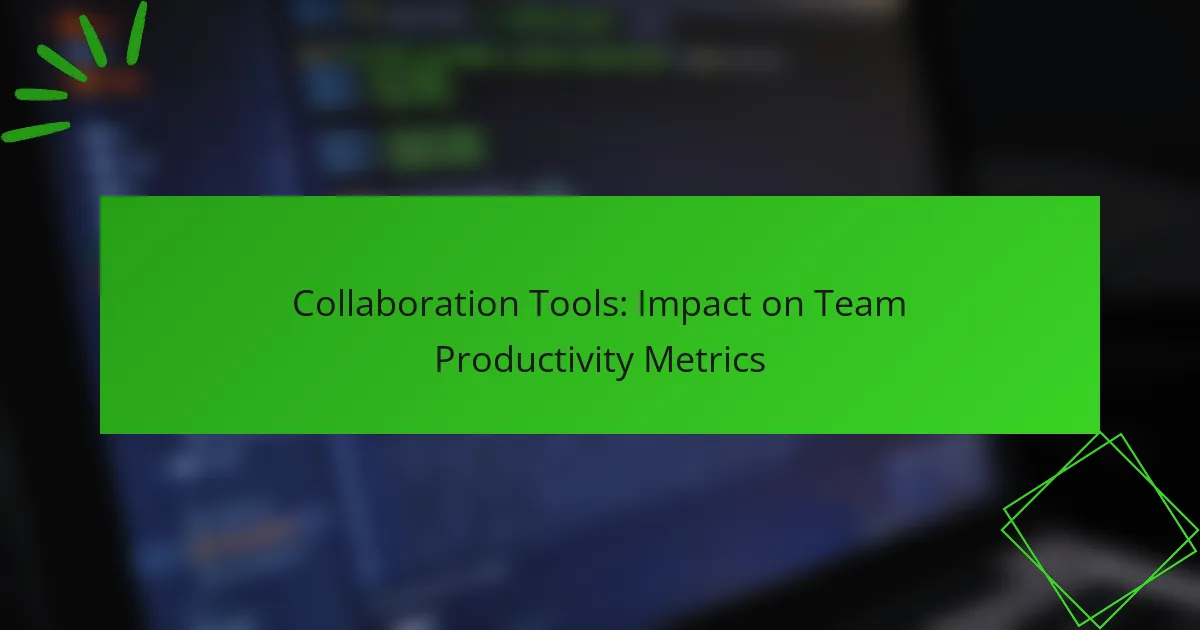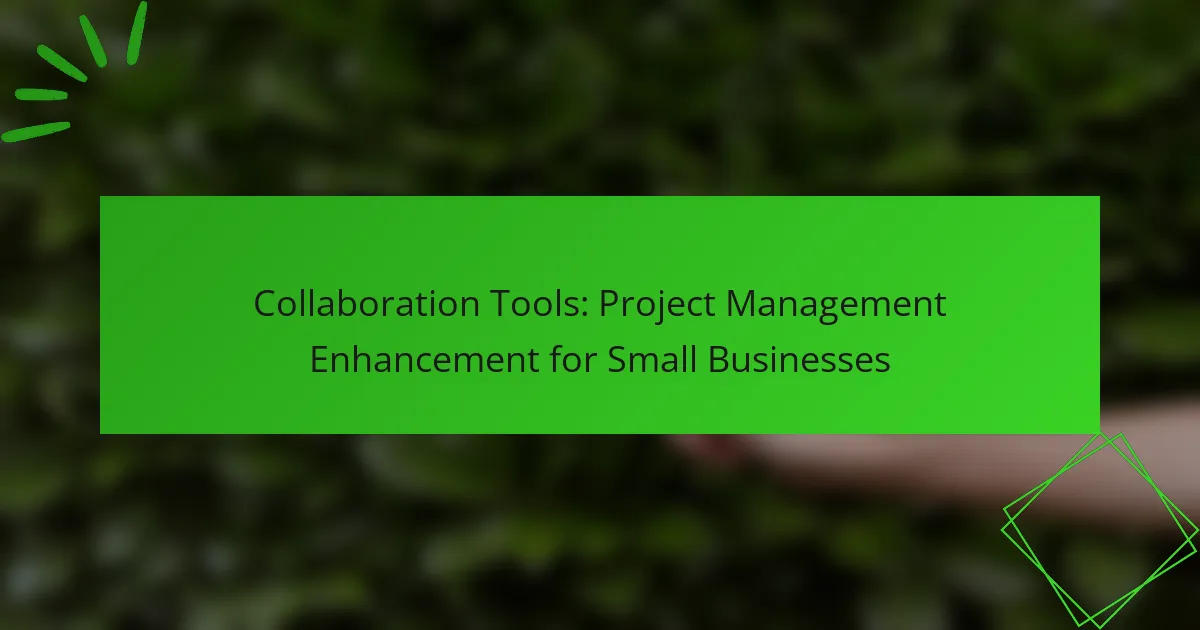Collaboration tools designed for integration with workflow systems play a crucial role in enhancing team communication and streamlining processes. By facilitating seamless connectivity with existing systems, these tools significantly boost productivity and efficiency, enabling teams to manage tasks more effectively. When choosing collaboration tools, it’s essential to prioritize features that support integration, ease of use, and mobile accessibility to foster a collaborative environment.

What are the best collaboration tools for workflow integration?
The best collaboration tools for workflow integration enhance team communication and streamline processes. These tools allow seamless connectivity with existing systems, improving efficiency and productivity across various tasks.
Slack
Slack is a popular messaging platform that integrates with numerous workflow systems, enabling real-time communication and collaboration. It supports various integrations with tools like Google Drive, Trello, and Asana, allowing users to share files and updates directly within channels.
To maximize its potential, teams should create dedicated channels for specific projects or topics. This organization helps keep conversations focused and relevant, reducing information overload.
Trello
Trello is a visual project management tool that utilizes boards, lists, and cards to organize tasks. Its integration capabilities allow users to connect with tools like Slack and Google Calendar, ensuring that updates and deadlines are communicated effectively.
When using Trello, consider setting up automation through Butler to streamline repetitive tasks. This feature can save time and reduce manual work, enhancing overall workflow efficiency.
Asana
Asana is designed for task management and project tracking, offering robust integration options with tools such as Slack, Microsoft Teams, and Dropbox. It allows teams to create tasks, assign responsibilities, and set deadlines, all while keeping communication centralized.
Utilizing Asana’s timeline view can help visualize project progress and dependencies. This feature is particularly useful for teams managing multiple projects simultaneously, ensuring that everyone stays aligned on priorities.
Microsoft Teams
Microsoft Teams combines chat, video conferencing, and file sharing in one platform, making it ideal for workflow integration within organizations using Microsoft 365. It integrates seamlessly with applications like SharePoint and OneDrive, enhancing collaboration on documents and projects.
To optimize Microsoft Teams, leverage its channel organization and tabs to create dedicated spaces for different projects or departments. This structure helps maintain clarity and focus in team communications.
Monday.com
Monday.com is a work operating system that allows teams to manage projects and workflows visually. It offers integrations with various tools, including Slack, Trello, and Google Drive, facilitating a cohesive workflow across platforms.
For effective use, teams should customize their boards to reflect specific workflows and processes. This adaptability allows for better tracking of progress and accountability among team members, ultimately improving productivity.

How do collaboration tools enhance productivity?
Collaboration tools significantly enhance productivity by facilitating seamless communication and efficient task management among team members. These tools integrate with workflow systems to streamline processes, reduce delays, and foster a collaborative environment.
Streamlined communication
Streamlined communication is essential for enhancing productivity in any team. Collaboration tools provide instant messaging, video conferencing, and file sharing, allowing team members to communicate effectively regardless of their location. This reduces the time spent on emails and meetings, enabling quicker decision-making.
For example, tools like Slack or Microsoft Teams allow for organized conversations in channels, which can be dedicated to specific projects or topics. This structure helps keep discussions focused and easily accessible, minimizing the risk of important information getting lost.
Task management efficiency
Collaboration tools improve task management by offering features that help teams assign, track, and prioritize tasks. Tools like Asana or Trello provide visual boards and lists that make it easy to see project progress and deadlines at a glance. This transparency helps teams stay aligned and accountable.
When using these tools, it’s crucial to establish clear guidelines for task assignments and updates. Regular check-ins can help ensure that everyone is on the same page and that tasks are completed on time, which ultimately boosts overall productivity.
Real-time collaboration
Real-time collaboration allows team members to work together simultaneously, regardless of their physical locations. Tools like Google Workspace or Notion enable multiple users to edit documents, spreadsheets, or presentations in real-time, which accelerates the creative process and reduces the need for back-and-forth revisions.
To maximize the benefits of real-time collaboration, teams should establish protocols for using these tools effectively. For instance, setting up regular collaborative sessions can enhance engagement and ensure that all voices are heard, leading to more innovative solutions and improved outcomes.

What are the key features to look for in collaboration tools?
When selecting collaboration tools, prioritize features that enhance integration with workflow systems, ensure ease of use, and provide mobile access. These elements are essential for fostering effective teamwork and maintaining productivity across various platforms.
Integration capabilities
Integration capabilities are crucial for collaboration tools as they allow seamless connectivity with existing workflow systems. Look for tools that support popular software and services like project management platforms, communication apps, and file storage solutions.
Consider tools that offer APIs or built-in integrations, enabling automatic data sharing and task synchronization. This reduces manual work and minimizes errors, enhancing overall efficiency.
User-friendly interface
A user-friendly interface is vital for ensuring that all team members can navigate the collaboration tool with ease. Choose tools that feature intuitive layouts, clear navigation, and customizable dashboards to suit different user preferences.
Testing the interface with a small group can provide insights into usability. Aim for tools that require minimal training, allowing teams to adopt them quickly and focus on their tasks rather than learning curves.
Mobile accessibility
Mobile accessibility allows team members to collaborate on-the-go, making it essential for modern work environments. Look for tools that offer robust mobile applications compatible with both iOS and Android devices.
Ensure that the mobile version retains core functionalities, such as document sharing, task management, and real-time communication. This flexibility supports remote work and enhances responsiveness, particularly in dynamic project settings.

How do you choose the right collaboration tool for your team?
Choosing the right collaboration tool involves understanding your team’s specific needs and workflows. Consider factors like team size, budget, and how well the tool integrates with existing systems to ensure it enhances productivity.
Assess team size and needs
Start by evaluating the size of your team and the nature of your projects. Smaller teams may benefit from simpler tools that facilitate quick communication, while larger teams might require more robust platforms that support complex project management features.
Identify the specific needs of your team, such as file sharing, video conferencing, or task management. This will help narrow down options that align with your workflow and enhance collaboration.
Evaluate budget constraints
Budget is a critical factor in selecting a collaboration tool. Determine how much your team can allocate monthly or annually for software subscriptions. Many tools offer tiered pricing, so assess what features are essential and whether a free or lower-cost option meets your needs.
Keep in mind that some tools may charge per user, while others offer flat rates. Consider the total cost of ownership, including potential upgrades or additional features that may be necessary as your team grows.
Consider integration with existing tools
Check how well potential collaboration tools integrate with the software your team already uses. Seamless integration can save time and reduce friction in workflows, allowing for smoother transitions between tasks.
Look for tools that offer APIs or built-in integrations with popular platforms like Google Workspace, Microsoft 365, or project management software. This ensures that your team can maintain productivity without having to switch between multiple applications frequently.

What are the common challenges in integrating collaboration tools?
Integrating collaboration tools into existing workflow systems often presents several challenges that can hinder effectiveness. Key issues include data silos, user adoption resistance, and compatibility problems, each requiring careful consideration for successful integration.
Data silos
Data silos occur when information is stored in isolated systems that do not communicate with each other. This fragmentation can lead to inefficiencies, as team members may struggle to access the data they need for effective collaboration. To mitigate this, organizations should prioritize tools that offer seamless integration capabilities with existing systems.
For example, using APIs can facilitate data sharing between collaboration tools and other software, reducing the risk of silos. Regular audits of data flow can also help identify and eliminate any emerging silos.
User adoption resistance
User adoption resistance is a common barrier when introducing new collaboration tools. Employees may be hesitant to change their established workflows, fearing that new tools will complicate their tasks. To address this, organizations should involve users in the selection process and provide comprehensive training to demonstrate the benefits of the new tools.
Offering incentives for early adopters and showcasing success stories can also encourage broader acceptance. Continuous support and feedback mechanisms can help users feel more comfortable with the transition.
Compatibility issues
Compatibility issues arise when new collaboration tools do not integrate well with existing software and systems. This can lead to disruptions in workflow and decreased productivity. Organizations should conduct thorough compatibility assessments before implementing new tools to ensure they work harmoniously with current systems.
Consider using platforms that support common standards and protocols, as this can significantly reduce compatibility challenges. Regular updates and maintenance of both new and existing systems can also help maintain smooth integration over time.

How can you overcome integration challenges?
To overcome integration challenges, it’s essential to identify the specific barriers and implement strategic solutions. Common issues include compatibility, data flow, and user adoption, which can be addressed through careful planning and the right tools.
Identify key integration points
Start by mapping out the workflows and processes that require integration. Identify the systems involved and the data that needs to flow between them. This clarity will help pinpoint where integration is most critical and where potential bottlenecks may arise.
For example, if you’re integrating a project management tool with a communication platform, focus on how task updates will be shared and what information needs to be visible in both systems. This ensures that all team members have access to the same data, enhancing collaboration.
Choose the right tools
Select tools that are designed for seamless integration with your existing workflow systems. Look for platforms that offer APIs or built-in connectors to facilitate data exchange. Popular options include Zapier, Integromat, and Microsoft Power Automate, which can automate tasks between various applications.
When evaluating tools, consider their ease of use and the level of support they provide. A user-friendly interface can significantly reduce the learning curve and encourage team adoption.
Test and iterate
Before fully implementing an integration, conduct thorough testing to identify any issues. This may involve running pilot programs with a small group of users to gather feedback and make necessary adjustments. Iteration is key to refining the integration for optimal performance.
For instance, if a new tool is not providing the expected data flow, assess the configuration settings and make adjustments based on user feedback. Continuous improvement will help ensure that the integration meets the evolving needs of your team.
Train your team
Providing adequate training for your team is crucial for successful integration. Ensure that all users understand how to use the new tools and workflows effectively. This can be achieved through workshops, tutorials, or one-on-one sessions.
Encourage open communication during this phase, allowing team members to share their experiences and challenges. This feedback can help identify areas where additional training may be needed, ultimately leading to a smoother integration process.










